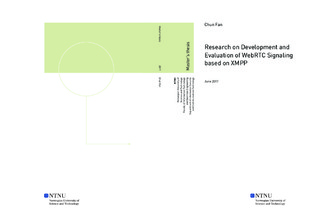| dc.description.abstract | Web is becoming more and more popular. Web Real-time Communication (WebRTC), as one of the new technologies based on Web, makes real-time communication easy to be used through the Web.
However, WebRTC is not a standardization responsible for specifying protocols.
Therefore, there are many solutions proposed in WebRTC signaling.
JavaScript Object Notation (JSON) and EXtensible Markup Language (XML) via XMLHttpRequest (XHR), both of them support defining objects and transferring data, and thus can be used in solutions of implementing signaling.
HTTP Comet and WebSocket, that enable pushing data from server to client, can be good solutions for implementing signaling.
Mature protocols such Session Initiation Protocol (SIP) and Extensible Messaging and Presence Protocol (XMPP) are also good solutions.
Moreover, combination of XMPP, SIP, Jingle or constructing own protocol carrying Session Description Protocol-like (SDP -like) information can also work for signaling.
XMPP as a mature protocol, which is open standard for messaging and presence, is one of those proposed signaling solutions for WebRTC. As XMPP has features of openness, standardization, provenness, decentralized, security, flexibility and diversity, it is chosen as solution for WebRTC signaling to be studied.
In order to verify whether XMPP is a valid solution for WebRTC signaling, this project develops WebRTC application with two solutions for WebRTC signaling. The first one is a straightforward way of using XMPP whereas the second one introduces modifications targeting to improve the performance.
The project first designed and implemented one model that WebRTC supported browser connects to XMPP server directly which is the straightforward way to achieve.
Since XMPP is a heavy text based protocol which may lead to too much traffic through the Internet, this project designed and implemented another model that building a middleware server on the same sever as XMPP server.
So WebRTC browser communicates with the middleware sever with core information and the middleware server communicates with XMPP server with XMPP supported message, and thus the majority of traffic are moved from Internet to local.
It is then expected that the latter model may improve performance of delay for WebRTC signaling.
In addition, to analyze two models, the validation methods have also been implemented.
These methods includes setting timestamps according to different steps in signaling process, capturing and computing data flow size according to messages sent and received during signaling process, and also recording number of candidates which affect the performance of signaling process.
Besides, many technologies have been studied and applied during implementations, as well as many challenges.
Analysis was then conducted after implementation.
It is demonstrated that XMPP as WebRTC signaling method can be a valid solution, since call can be set up successfully between users.
In addition, methods of measurement including recoding timestamp, data flow size and number of candidates also work fine, since all data which is needed are recored.
It also finds out in quantity that building a middleware server together with XMPP server can move most data from Internet to local.
However, building a middleware server can not guarantee less delay. But the delay is more stable in the model with middlware than in the model with direct connection to XMPP server.
Interactive Connectivity Establishment candidate (ICE candidate) as an important role in WebRTC signaling, which is an object containing information for establishing communication between peers, affects much on delay performance of WebRTC signaling. More research on ICE candidate can help to improve the delay performance of WebRTC signaling.
WebRTC is an interesting topic and it is proved by this project that WebRTC is a nice technology for peer to peer communication, and XMPP works fine as a solution for WebRTC signaling. | |

